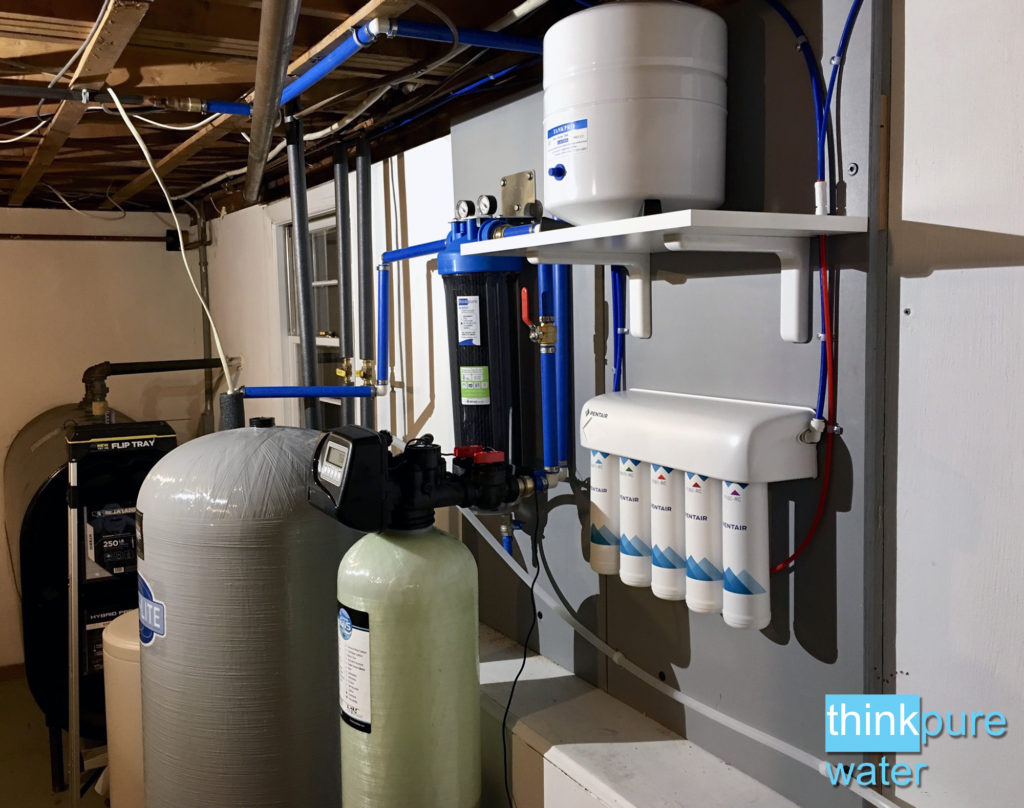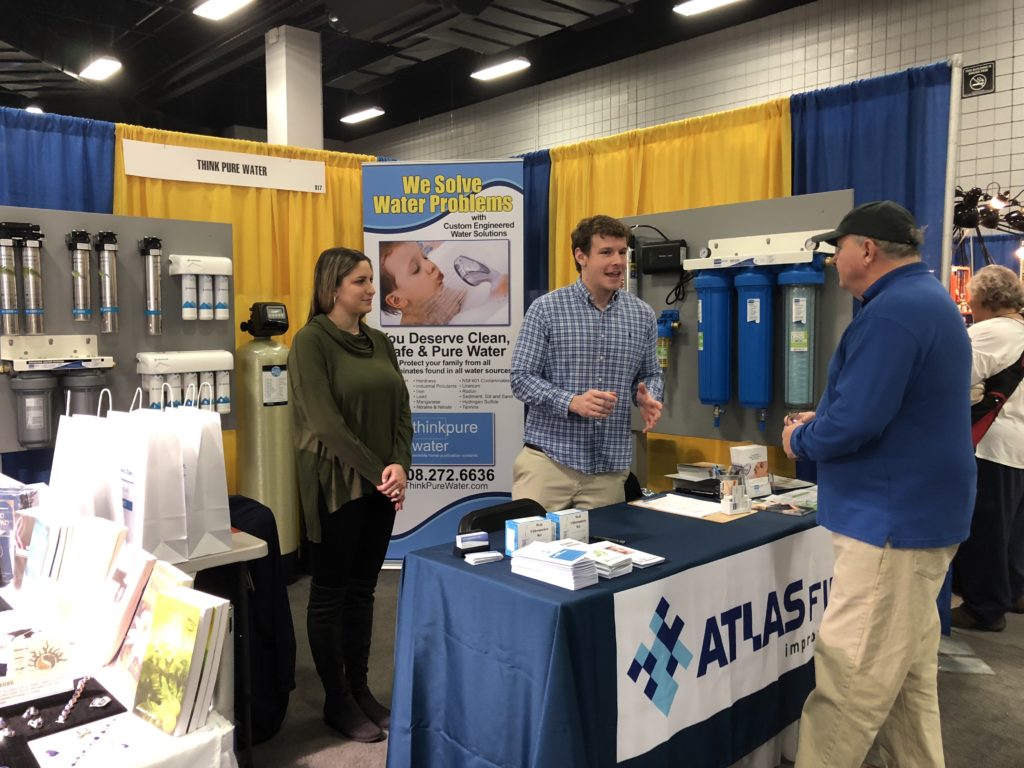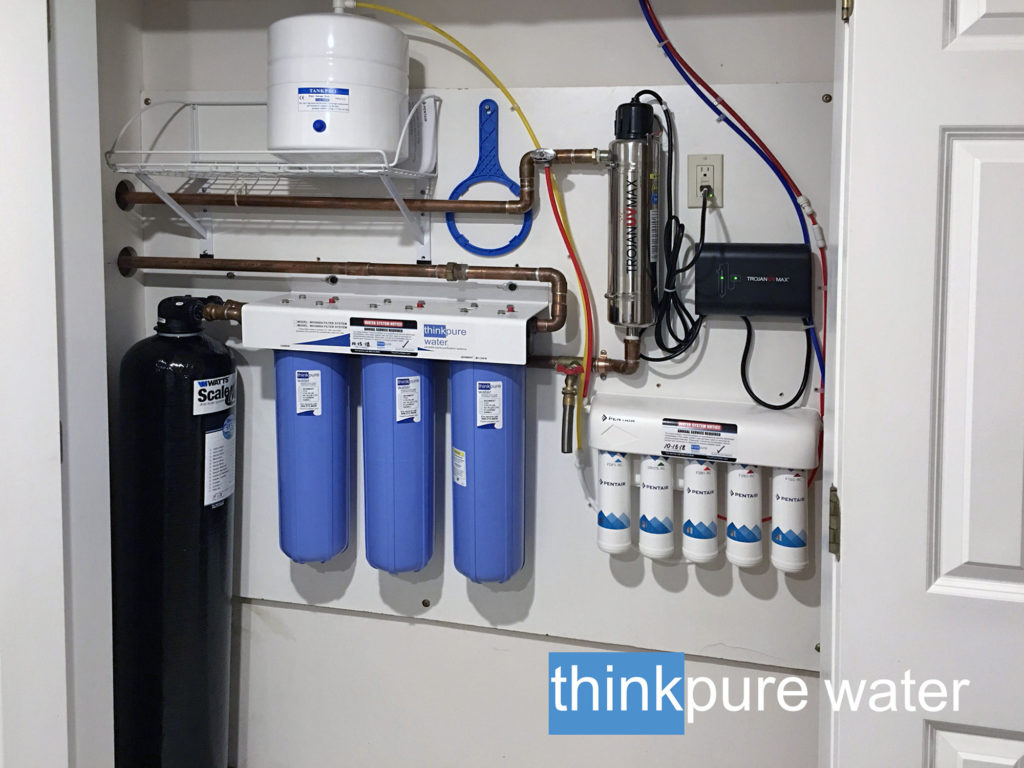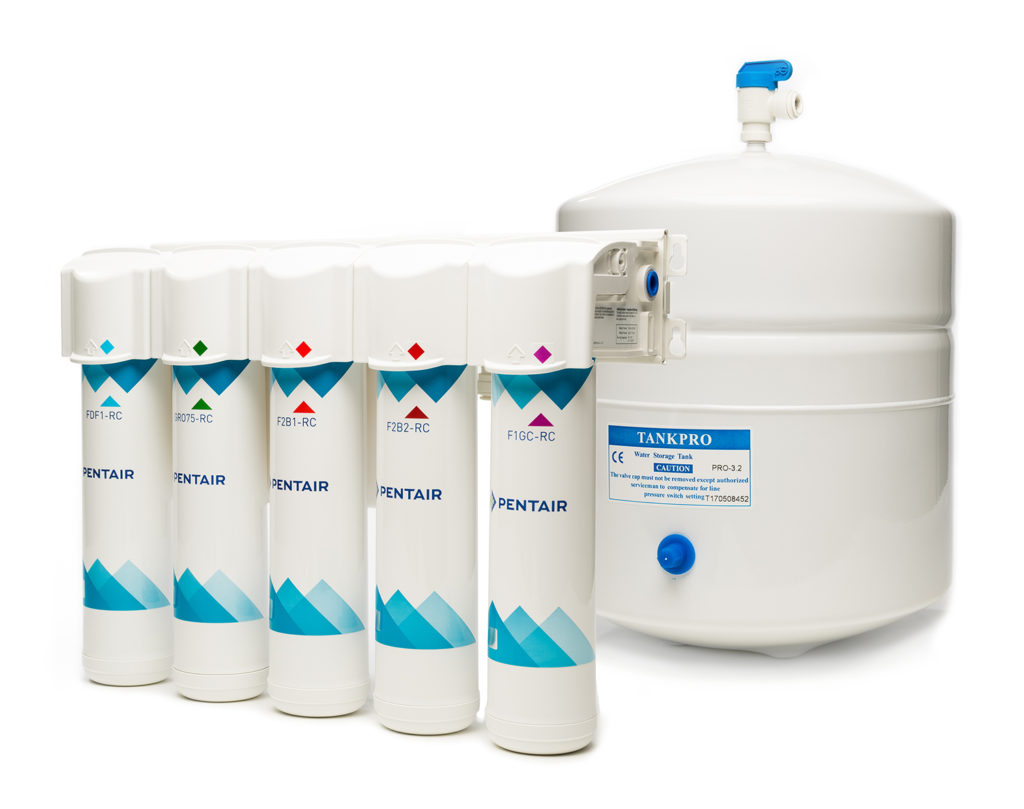May 27, 2019 | Filtration, Reverse Osmosis, Water Softening

Water Filtration – Water Softener – Hard Water – Reverse Osmosis in Dover – Sherborn MA. In this project, a young family moved into a 1960’s home with no filtration in place. Plumbing fixtures were badly stained with iron & manganese to the point of needing replacement. Shower heads and valves were virtually seized up with hard scale. Based on test results, TPW designed this system which included a new well pressure tank, a wall mounted sediment filter, a water softener and a 5 stage reverse osmosis filter for drinking and cooking water. All TPW installs are carefully planned out to include prepared plywood panels & blocking. RO storage tanks are never left on the floor. Keeping the storage tank up as high as possible creates robust flow at the faucet. The homeowners were thrilled with the installation and finished water quality. ThinkPureWater is a local, Framingham based, family owned business. Call TPW for free in home consultation @ 508.272.6636.
Nov 26, 2018 | Commercial, Reverse Osmosis, UV Sterilizer, Water Softening & Filtration, Whole House Water Filtration

ThinkPureWater & ETR Labs at 2018 Natural Living Expo in Marlborough MA
TPW had a great responce from the 12,000 attendees at the 2018 Natural Living Expo. Featured were Pentair Everpure commercial grade drinking water filters, Clack water softeners and conditioning systems, Atlas Filtri’s comprehensive line of Italian made water filter systems. Call us at 508.272.6636 for free consultation. We offer comprehensive water testing and professional systems engineering for every type of water problem.
Feb 27, 2018 | Reverse Osmosis, Salt Free Scale Control, UV Sterilizer, Whole House Water Filtration
 At ThinkPureWater, we can design, build and install purification systems that address a variety of criteria. This project was designed for a home wellness spa with a large steam shower in Natick MA. The system pictured here incorporates the WH 3000A Whole House Filter followed by a Scale Net Water Conditioner. This unit conditions the water to prevent hardness minerals from forming scale buildup on plumbing fixtures and etching of shower glass. It can also prevent scale buildup in the steam generator leading to costly repairs. With the chlorine and other disinfectant chemicals removed by the WH3000A, a UV Sterilizer System was installed to assure microbiologically safe water throughout the home regardless of what may enter thru the water main. Finally, a 5 Stage Reverse Osmosis System was added for drinking water directed to a new small faucet at the kitchen sink as well as the fridge ice maker. The homeowners were thrilled with the project and came to realize it was the one of the most important purchases they ever made. Call us today for a free in home consultation. 508.272.6636
At ThinkPureWater, we can design, build and install purification systems that address a variety of criteria. This project was designed for a home wellness spa with a large steam shower in Natick MA. The system pictured here incorporates the WH 3000A Whole House Filter followed by a Scale Net Water Conditioner. This unit conditions the water to prevent hardness minerals from forming scale buildup on plumbing fixtures and etching of shower glass. It can also prevent scale buildup in the steam generator leading to costly repairs. With the chlorine and other disinfectant chemicals removed by the WH3000A, a UV Sterilizer System was installed to assure microbiologically safe water throughout the home regardless of what may enter thru the water main. Finally, a 5 Stage Reverse Osmosis System was added for drinking water directed to a new small faucet at the kitchen sink as well as the fridge ice maker. The homeowners were thrilled with the project and came to realize it was the one of the most important purchases they ever made. Call us today for a free in home consultation. 508.272.6636
Feb 12, 2016 | Reverse Osmosis
Congratulations on you new Reverse Osmosis Water System from Think Pure Water.
RO systems produce some of the purest water in the world. The least amount of water is wasted when you use the whole tank full and let it fill again from empty. Its best to simply fill water jugs and leave them in the fridge or on the counter. Taking a glass from a full tank wastes the most water.
Empty your RO tank every month. Here is why. RO membranes are generally self cleaning as waste water clears away most hardness minerals and impurities. When the tank is empty, there is no back pressure on the membrane and this allows the most effective flushing of the impurities. Taking a glass of water from a full tank never allows the membrane to clear itself. Simply emptying the tank every month greatly increases the life of the membrane.
STARTING UP your newly installed system. All RO systems produce water slowly and also produce reject water in the process. Therefore, a storage tank is necessary so plenty of pure water is always available. The first TWO full tanks MUST be discarded into the drain to clear the system of disinfectant crystals in the tank. (These are not toxic but won’t taste good)
STEP 1. When first installed, allow the 2.5 gallon tank to fill completely ….. about 1 to 2 hours. If you listen closely to the disposal drain in the sink, you can often, but not always, hear the reject water passing thru there. When the noise stops, the tank is full. You can also lift the tank to feel if it is full.
STEP 2. Open the new RO faucet and drain the tank to empty ….. about 4 to 6 minutes. A small dribble means the tank is empty. This is the new RO water being made but won’t fill the tank unless you shut off the faucet.
STEP 3. SHUT OFF THE FAUCET ….. so the tank can refill. If you don’t, the water that’s supposed to fill the tank will dribble out the faucet continuously.
STEP 4. Let the tank fill again ….. about 1 to 2 hours.
STEP 5. Open the new RO faucet and drain the tank to empty ….. about 4 to 6 minutes.
STEP 6. SHUT OFF THE FAUCET AGAIN and let the tank fill ….. about 1 to 2 hours.
This 3rd tank is now ready to enjoy.
Thanks from Think Pure Water
Jan 7, 2016 | Reverse Osmosis
 How it works / What is does RO systems work by forcing water at house pressure thru a semi permeable membrane that, in conjunction with its carbon pre filters, rejects 95 to 99% plus of all contaminates and as well as hardness minerals. RO systems can reach high levels of purity as bacteria, microorganisms as well as arsenic, lead, fluoride and even pharmaceutical pollutants are removed. Carbon based filters such as countertop or box store filters cannot remove all of these impurities. RO water tastes delicious, makes superior coffee, tea, ice and is great to cook with.
How it works / What is does RO systems work by forcing water at house pressure thru a semi permeable membrane that, in conjunction with its carbon pre filters, rejects 95 to 99% plus of all contaminates and as well as hardness minerals. RO systems can reach high levels of purity as bacteria, microorganisms as well as arsenic, lead, fluoride and even pharmaceutical pollutants are removed. Carbon based filters such as countertop or box store filters cannot remove all of these impurities. RO water tastes delicious, makes superior coffee, tea, ice and is great to cook with.
Smaller residential Reverse Osmosis units In smaller residential RO units, water is produced slowly. It takes about 1 to 2 hours (depending on house water pressure, incoming water hardness and temperature) to fill the 2-1/2 or 5 gallon tank. Premium systems have a sediment filter, two carbon pre-filters, an RO membrane and a final carbon finishing filter, thus a 5 stage unit. The unit and the holding tank take up about 1/3 of the storage space of a 36″ sink cabinet. A small separate faucet is installed in the countertop, which can swing in for filling a pot or water jug on the countertop. Drilling thru granite or other material is required. This size unit, will produce enough pure water for drinking, cooking and ice making for a typical family. Although the faucet is small, when these units are correctly installed, the flow is robust and you can fill a glass in about 5 seconds and a medium size pot in 40 seconds or so.
RO Reject Water All RO units produce reject water which is directed into the sink drain. About 2-3 gallons is rejected for every 1 gallon produced but this amount can be minimized. (See below). The carbon filters remove chlorine, VOCS and the membrane rejects fluoride, lead, arsenic as well as hundreds of various chemicals, biological contaminates and hardness minerals. The rejected water basically returns to the hydrological cycle and is not really “wasted”. Drinking RO purified municipal water is less polluting by far than consuming plastic bottled water when all things are taken into account.
RO water is soft water similar to rainwater The process of producing RO water necessarily removes virtually all potentially beneficial minerals that may be present in the incoming water. It is estimated that we receive 99% plus of our minerals from food, so as long as a person eats reasonable quality food, there is no real concern that one might become mineral deficient from drinking RO water. It is worth noting that RO water is similar to rainwater. The Earth is continually demineralizing its waters and depositing it as surface water for all living things to drink and absorb. if birds can fly across oceans and squirrels can bolt up the side of a tree, it can’t possibly be unhealthy to drink demineralized water. Minerals, derived from plant and animal sources are abundant, broken down, considered organic, and are thus far more bio-available than than raw minerals in unprocessed water. There is more calcium in a glass of orange juice or a serving of kale than in 30 gallons of typical municipal water. A single multivitamin contains a more minerals than the water an average person consumes in a month. In essence, the importance of NOT consuming known dangerous pollutants and even nowadays, trace amounts of pharmaceutical drugs, outweighs by magnitudes, unfounded concerns of mineral deficiencies sometimes wrongly associated with consuming RO water.
A squeeze of lemon juice and a few grains of salt turns any purified water into an alkalizing and refreshing drink The RO process necessarily lowers the PH of the finished water to a more acidic condition. This issue, is for some persons, a concern as our bodies always strive to maintain a neutral PH of 7.35 to 7.45 through homeostasis. Our overall wellness in relation to the PH of various foods, beverages and water consumption is an extremely complex subject and can fill a book. Our stomach acid and lemon juice have a PH of around 2, so our own bodies adjust the PH levels of its various fluids to maintain optimal operations and life processes. If our stomach acids were too alkaline, we could not digest our food properly. Acidic citrus fruits actually end up creating alkaline conditions in our bodies so the processes are not as simple as one might think. A squeeze of lemon juice and a few grains of salt turns any purified water into an alkalizing and refreshing drink. The real culprits of an acidic body condition are what we eat, such as processed foods, refined carbohydrates, hydrogenated (damaged) fats, sweets, alcohol, processed meats, dairy and coffee. Dr Mercola recommends RO water as safe and healthy. Nature,s RO water is rainwater, distilled thru evaporation and millions of people and virtually every animal drink it every day with no ill effects.
Better than bottled water Using your new RO system is a great experience as you can now have better than bottled water for a fraction of the cost. Supporting the plastic bottled water industry, lugging cases of water and recycling bottles can be a thing of the past. Everything you make will taste better especially coffee, tea and soups. Drink from real glasses and buy glass travel bottles for your RO water. Avoid plastic containers as they can leach harmful chemicals into any liquid surrounding them.
To minimize waste water form your RO system, it is necessary to fill up a couple of water jugs in the morning. You can also fill up a covered pot kept next to the faucet and ladle it out for cooking. As it refills, back pressure from the tank, on the membrane builds and resists RO water production, gradually increasing the amount of reject water per ounce of RO water produced. The most water will be wasted by taking just one glass from a full tank. This doesn’t mean you can’t ever grab a glass form a full tank once in a while. Taking most or ALL the water from the tank minimizes the amount of reject water. It is also important to empty the tank once a month or so anyway. If you go away for 3 or 4 weeks, drain it to empty and let it refill again when you come home.
A well built and maintained RO unit can last indefinitely There are reports of 25 plus years of operation from users. Incoming water conditions and usage affect the maintenance requirements. For average water and family usage the sediment and carbon filters must be changed out every 10 to 12 months. With a whole house filter system, you can go up to 24 months. The RO membrane is extremely sensitive to chlorine and will fail if the unit is not maintained. During maintenance, we check the TDS (total dissolved solids) PPM (parts per million) reading on a meter to be sure it’s working properly. Incoming water with a 250 to 350 ppm reading will, with a well functioning RO membrane, show a PPM of 25 to 35 for purified water. Membranes should be changed every 3 to 5 years to minimize reject water.
A word on RO faucets In Massachusetts all RO installs must use an “air gap” faucet to meet the plumbing code. Because the reject water is directed to the drain, a back flow preventer is necessary and an air gap faucet is an accepted back flow preventer. An air gap faucet has 3 hoses connected to it. Besides the pure RO water in an isolated hose going to the faucet valve, the is a 1/4″ hose sending reject water into a small pool inside the base of the RO faucet on top of the counter. The pool never fills up as there is also a larger 3/8″ hose in the bottom of the pool draining to the sink tailpiece. A small hole is drilled in the back of the faucet base to allow air in or out of the drain / pool chamber. It the rare event of a house pressure loss and an even rarer suction of water BACKWARDS in the pipes, the air gap faucet will protect the RO unit from sucking waste water from the sink drain back into its filters and thus polluting the filter system. RO systems sold in box stores do not come with 3 hose ” air gap ” faucets and do not meet our local plumbing code. We also supply a code approved drain line adapter which allows the RO reject water to drain into the disposal unit.
RO units make some amount of noise It is normal for RO units to make the sound of flowing, trickling water while the unit is replenishing itself. Sounds can come from the air gap faucet as well as from the sink drain. It’s not very loud and you get used to it. It completely stops all of a sudden when the tank is full so you know you have plenty of great quality drinking water ready.
The ultimate system An RO in combination with a good Whole House Filter System such as our WH3500-IT is the ultimate system. The RO system is pampered and protected by its feed water already being highly purified allowing for extended filter life and really astounding quality drinking water.



 At ThinkPureWater, we can design, build and install purification systems that address a variety of criteria. This project was designed for a home wellness spa with a large steam shower in Natick MA. The system pictured here incorporates the WH 3000A Whole House Filter followed by a Scale Net Water Conditioner. This unit conditions the water to prevent hardness minerals from forming scale buildup on plumbing fixtures and etching of shower glass. It can also prevent scale buildup in the steam generator leading to costly repairs. With the chlorine and other disinfectant chemicals removed by the WH3000A, a UV Sterilizer System was installed to assure microbiologically safe water throughout the home regardless of what may enter thru the water main. Finally, a 5 Stage Reverse Osmosis System was added for drinking water directed to a new small faucet at the kitchen sink as well as the fridge ice maker. The homeowners were thrilled with the project and came to realize it was the one of the most important purchases they ever made. Call us today for a free in home consultation. 508.272.6636
At ThinkPureWater, we can design, build and install purification systems that address a variety of criteria. This project was designed for a home wellness spa with a large steam shower in Natick MA. The system pictured here incorporates the WH 3000A Whole House Filter followed by a Scale Net Water Conditioner. This unit conditions the water to prevent hardness minerals from forming scale buildup on plumbing fixtures and etching of shower glass. It can also prevent scale buildup in the steam generator leading to costly repairs. With the chlorine and other disinfectant chemicals removed by the WH3000A, a UV Sterilizer System was installed to assure microbiologically safe water throughout the home regardless of what may enter thru the water main. Finally, a 5 Stage Reverse Osmosis System was added for drinking water directed to a new small faucet at the kitchen sink as well as the fridge ice maker. The homeowners were thrilled with the project and came to realize it was the one of the most important purchases they ever made. Call us today for a free in home consultation. 508.272.6636 How it works / What is does RO systems work by forcing water at house pressure thru a semi permeable membrane that, in conjunction with its carbon pre filters, rejects 95 to 99% plus of all contaminates and as well as hardness minerals. RO systems can reach high levels of purity as bacteria, microorganisms as well as arsenic, lead, fluoride and even pharmaceutical pollutants are removed. Carbon based filters such as countertop or box store filters cannot remove all of these impurities. RO water tastes delicious, makes superior coffee, tea, ice and is great to cook with.
How it works / What is does RO systems work by forcing water at house pressure thru a semi permeable membrane that, in conjunction with its carbon pre filters, rejects 95 to 99% plus of all contaminates and as well as hardness minerals. RO systems can reach high levels of purity as bacteria, microorganisms as well as arsenic, lead, fluoride and even pharmaceutical pollutants are removed. Carbon based filters such as countertop or box store filters cannot remove all of these impurities. RO water tastes delicious, makes superior coffee, tea, ice and is great to cook with.